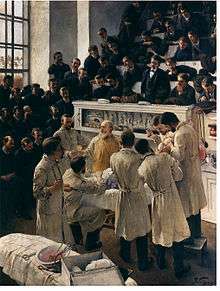Theodor Billroth
| Theodor Billroth | |
|---|---|
 | |
| Born |
Christian Albert Theodor Billroth 26 April 1829 Bergen auf Rügen, Kingdom of Prussia |
| Died |
6 February 1894 (aged 64) Opatija, Austria-Hungary |
| Education | University of Greifswald, University of Göttingen, University of Berlin |
| Known for |
Being the founding father of modern abdominal surgery Applying scientific methods to musicality |
|
Medical career | |
| Profession | Surgeon |
| Institutions |
Surgical hospital and clinic, Zurich University of Zurich Allgemeine Krankenhaus University of Vienna |
| Specialism | Abdominal surgery |

Christian Albert Theodor Billroth (26 April 1829 – 6 February 1894) was a Prussian-born Austrian surgeon and amateur musician.
As a surgeon, he is generally regarded as the founding father of modern abdominal surgery. As a musician, he was a close friend and confidant of Johannes Brahms, a leading patron of the Viennese musical scene, and one of the first to attempt a scientific analysis of musicality.
Early life and education
Billroth was born at Bergen auf Rügen in the Kingdom of Prussia. He went to school in Greifswald. He was an indifferent student, and spent more time practicing piano than studying. Torn between a career as a musician or as a physician, he acceded to his mother's wishes and enrolled himself at the University of Greifswald to study medicine. He then followed his professor, Wilhelm Baum, to the University of Göttingen, and completed his medical doctorate at the University of Berlin. Along with Rudolph Wagner (1805–1864) and Georg Meissner (1829–1905), Billroth went to Trieste to study the torpedo fish.[1]
Surgery
Billroth worked as a doctor from 1853–1860 at the Charité in Berlin. In Berlin he was also apprenticed to Carl Langenbuch. From 1860–1867 he was Professor at the University of Zurich and director of the surgical hospital and clinic in Zurich. While in Zurich, Billroth published his classic textbook Die allgemeine chirurgische Pathologie und Therapie (General Surgical Pathology and Therapy) (1863). At the same time he introduced the concept of audits, publishing all results, good and bad, which automatically resulted in honest discussion on morbidity, mortality, and techniques – with resultant improvements in patient selection. He was appointed professor of surgery at the University of Vienna in 1867 and practiced surgery as chief of the Second Surgical Clinic at the Allgemeine Krankenhaus (Vienna General Hospital).[2]
An early adopter of the "white coat (as shown in Seligmann's c.1890 painting),[3] Billroth was directly responsible for a number of landmarks in surgery, including the first esophagectomy (1871), the first laryngectomy (1873), and most famously, the first successful gastrectomy (1881) for gastric cancer, after many ill-fated attempts. Legend has it that Billroth was nearly stoned to death in the streets of Vienna when his first gastrectomy patient died after the procedure.
Billroth was instrumental in establishing the first modern school of thought in surgery. Among his disciples were luminaries such as Alexander von Winiwarter, Jan Mikulicz-Radecki and John B. Murphy. William Halsted's pioneer surgical residency program was greatly influenced by Billroth's own methods of surgical education.
Music
Billroth was a talented amateur pianist and violinist. He met Brahms in the 1860s, when the composer was a rising star of the Viennese musical scene. They became close friends and shared musical insights. Brahms frequently sent Billroth his original manuscripts in order to get his opinion before publication, and Billroth participated as a musician in trial rehearsals of many of Brahms' chamber works before their first performances. Brahms dedicated his first two string quartets, Opus 51, to Billroth.
Billroth and Brahms, together with the acerbic and influential Viennese music critic Eduard Hanslick, formed the core of the musical conservatives who opposed the innovations of Richard Wagner and Franz Liszt. In the conflict, known as the War of the Romantics, Billroth supported Brahms, but was always fair and measured in his comments. "Wagner was indeed a very considerable talent in many directions," he wrote in 1888.[4]
Billroth started an essay called "Wer ist musikalisch?" ("Who is musical?"), which was published posthumously by Hanslick. It was one of the earliest attempts to apply scientific methods to musicality. In the essay, Billroth identifies different types of amusicality (tone deafness, rhythm-deafness and harmony-deafness) that suggest some of the different cognitive skills involved in the perception of music. Billroth died in Opatija, Austria-Hungary, before he could complete the research.
Excelling at both his vocation and his avocation, Billroth never saw science and music as being in conflict. On the contrary, he considered the two to complement each other. "It is one of the superficialities of our time to see in science and in art two opposites," he wrote in a letter. "Imagination is the mother of both."[5]
Footnotes
- ↑ Kazi, RA; Peter, RE (2004). "Christian Albert Theodor Billroth: Master of surgery" (PDF). Journal of postgraduate medicine. 50 (1): 82–3. PMID 15048012.
- ↑
 Chisholm, Hugh, ed. (1911). "Billroth, Albert Christian Theodor". Encyclopædia Britannica. 3 (11th ed.). Cambridge University Press.
Chisholm, Hugh, ed. (1911). "Billroth, Albert Christian Theodor". Encyclopædia Britannica. 3 (11th ed.). Cambridge University Press. - ↑ Hardy, Susan and Corones, Anthony, "Dressed to Heal: The Changing Semiotics of Surgical Dress", Fashion Theory, (2015), pp.1-23. doi=10.1080/1362704X.2015.1077653
- ↑ Letter written Sept. 3, 1888, translated in Dorothy Schullian and Max Schoen, Music and Medicine (1948) New York, Henry Schuman, Inc.
- ↑ Letter to Lubke, quoted in Sunderman, FW (1937). "Theodor Billroth As Musician". Bulletin of the Medical Library Association. 25 (4): 209–20. PMC 233819
 . PMID 16016309.
. PMID 16016309.
Further reading
- Engel, H. (1970–80). "Billroth, Christian Albert Theodor". Dictionary of Scientific Biography. 2. New York: Charles Scribner's Sons. pp. 129–131. ISBN 978-0-684-10114-9.
- Christian Albert Theodor Billroth: Master of surgery
- Theodor Billroth's biographic sketch at Find A Grave
- Telitschkin I., Theodor Billroth (1829-1894) in Russland. Würzburger medizinhistorische Mitteilungen. Band 23, S. 385-392. Würzburg: Verlag Königshausen & Neumann GmbH, 2004.
External links
| Wikimedia Commons has media related to Theodor Billroth. |